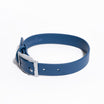Cats are natural hunters, and to them, ankles can look a lot like prey. If you have ever asked, why does my cat bite my ankles, the answer might surprise you.
This behavior is not random—it often ties back to instincts, habits, and play behavior. Imagine being a small predator hunting for prey. That is exactly how many cats see the world around them with our feet being a prime target.
Some adult cats outgrow this habit, but others keep at it. Continue reading to uncover the real reasons behind ankle attacks and how to stop the sneak bites.
Why Do Cats Bite Ankles?

Cats often bite ankles because your moving feet resemble fleeing prey. The quick motion across the floor triggers their natural prey drive, and if they do not have enough toys or outlets to release that energy, your ankles become the target. It is not personal—they are just doing what comes naturally.
This kind of biting usually falls under play aggression. If your cat chases your feet, there is a good chance they also swipe at your hands or fingers when you are relaxing. It can be hard to tell if it is play or actual aggression, but there are ways to spot the difference.
The ASPCA notes that playful cats tend to be relaxed and may have their mouths slightly open without growling or hissing. Truly angry cats, on the other hand, will growl, hiss, or possibly bite with force.
However, even playful biting can hurt, especially when cats get too excited. They do not always understand how rough is too rough. If you want to stop ankle attacks
it is important to guide your cat's energy in a new direction through training, toys, and better play habits.
Hunting Instincts
Cats are natural hunters, and moving ankles can trigger those instincts. When you walk by, your feet mimic the movements of small prey animals like mice or birds. This makes your ankles a tempting target for a quick pounce or bite. Both kittens and adult cats can show this behavior, especially if they are full of energy.
Without enough toys or proper play sessions, these instincts come out in less helpful ways. Encouraging hunting play with toys can keep their focus off your feet and onto something more appropriate.
Playful Behavior
Ankle biting is often just your cat trying to play. Many cats, especially young ones, learn how to control their biting through rough cat plays. But some never fully grow out of this stage and keep using their teeth during playtime.
If your cat seems bored or hyper, your feet might become their entertainment. This kind of behavior is usually harmless but can still hurt or be annoying. Keeping your cat entertained with interactive toys and daily play sessions can help redirect their energy.
Overstimulation or Excitement
Cats can go from chill to chaotic in just a few seconds. A simple walk across the room might spark excitement, leading to a surprise ankle attack. This happens when your cat gets overstimulated, especially during or after play.
Twitching tails, flattened ears, dilated pupils, and a crouching stance ready to pounce often come just before a sudden bite. Learning your cat's signals can help you calm them down before it escalates. Taking breaks during play can also prevent your cat from crossing that line from fun to frenzy.
Attention-Seeking Behavior
Sometimes, cats attack ankles because they know it works. They may want food, a toy, or just some love—and your feet are the easiest way to get your attention. If biting or scratching gets a reaction every time, they will keep doing it. This behavior usually shows up when your cat feels ignored, bored, or needs something.
Giving your cat attention before they resort to biting can stop it from becoming a habit. Try engaging with them in positive ways, like a quick play session or a treat.
Anxiety or Stress Triggers
Cats often react to change with unusual behavior, including biting. Things like new pets, new homes, loud noises, or even rearranged furniture can throw them off. If your cat starts attacking your ankles out of nowhere, their stress or frustration might be the cause. Watch for other signs like hiding, extra grooming, lack of appetite, or restlessness.
Creating a peaceful environment with cozy hiding spots can help them feel more secure. When your cat feels calm and safe, they are much less likely to take it out on your ankles.
My Cat Bite My Ankles When I Walk Away?
Walking away from your cat may seem harmless, but to them, it can feel like a game or even a goodbye they did not approve of. That quick movement can set off all kinds of reactions, from playful pounces to upset behavior.
- Fear of Abandonment or Separation Anxiety. Some cats struggle with the fear of being alone. When you walk away, they might panic and bite your ankles as a way to keep you nearby. This behavior is more common in cats that follow their person from room to room.
- Play or Prey Drive Triggered by Movement. Fast-moving feet can activate your cat's hunting instincts. Biting your ankles may feel like chasing prey or catching a toy mid-sprint. Many cats cannot resist the temptation of moving objects, especially when they are bored or under-stimulated.
The Use of Calming Aids to Ease Aggressive Behaviors
If your kitty's ankle attacks are starting to feel personal, it might be time to bring in some calm. Natural calming aids like CBD and Chamomile may help calm aggressive behavior and encourage better habits.
- Catnip and Valerian Root. Both catnip and valerian root may help take the edge off. These herbs may relax your cat or trigger mellow play behavior, making them less likely to bite ankles during moments of excitement.
- Chamomile for Soothing Effects. Chamomile has gentle calming properties. A kitty dealing with nervous or upset feelings might show fewer signs of agitation when chamomile is part of their wellness routine.
- HolistaPet CBD Cat Treats. These tasty salmon-flavored bites are more than just a reward. They may help support relaxation with broad-spectrum CBD and natural ingredients—no wheat, corn, or artificial junk included.
- CBD Calming Chews for Cats. Perfect for cats with nervous or agitated behaviors or those who get worked up during play. These chews offer comfort with every bite and may help ease overstimulation without causing drowsiness.
- CBD Capsules for Cats. A simple, clean, and predosed option. With hemp seed powder and CBD, they provide reliable support for soothing behavior and can be tucked into a favorite snack.
How to Stop Your Cat from Attacking Your Ankles

Tired of ankle attacks every time you walk across the room? Good news—there are fun, simple ways to address your cat's behavior. The key is keeping your cat engaged, comfortable, and focused. The tips below will help guide your kitty's energy in the right direction.
Training Your Cat with Positive Reinforcement
Positive reinforcement teaches your cat that good behavior leads to good rewards. When your cat walks by your ankles without biting, give them a treat, praise, or a favorite toy. This helps them link calm behavior with something they enjoy.
Unlike punishment, which can cause fear or confusion, rewards build trust. Cat owners who stay consistent with rewards will see better long-term results. Over time, your cat will start repeating the behavior that gets the reward.
Redirecting Attention to Toys
Ankle biting often happens because cats want to chase and play. Instead of using your feet as toys, give your cat something fun to chase like a teaser wand or stuffed mouse. These toys satisfy their hunting instincts in a safe, playful way.
Keep toys within reach during high-energy times of the day. The more your cat focuses on their toys, the less likely they are to chase your feet. Replacing biting with toy time helps build better habits.
Creating Safe Spaces for Your Cat
Cats need places where they feel secure and calm. A quiet spot with a soft bed, some blankets, or even a cardboard box can give your cat a calm place to unwind. These spaces allow your cat to relax when things feel too overwhelming.
Stress can lead to ankle biting or other upset behaviors. Cat owners should create spaces where their cats can retreat when needed. A calm and relaxed cat usually shows better behavior throughout the day.
Providing Sufficient Play and Stimulation
Without enough mental stimulation or physical activity, many cats look for other outlets—like biting your ankles. Daily play helps your cat use up that extra energy in fun and healthy ways. Toys that move or mimic small animals keep them mentally focused, stimulated, and satisfied. Play sessions also support your cat's natural hunting behaviors.
A well-exercised cat is more likely to nap than nip. Making play part of your daily routine can reduce unwanted behavior.
Providing Vertical Space for Exploration
Cats love climbing because it helps them feel in control of their space. Adding cat trees, window perches, or wall shelves gives them more ways to move around, explore, and stay occupied. These spots keep their minds busy and bodies active. Bored cats often act out, but vertical space helps redirect that energy.
Cats that can climb, perch, and observe tend to be more content. Giving your cat a place up high can lead to fewer ankle attacks.
Addressing Aggression in Cats: When to Seek Professional Help
Ankle biting may start as play, but if the behavior becomes more intense or aggressive, it could point to something deeper. Cats that bite hard, act unpredictably, or avoid interaction may be dealing with more than just boredom. When the biting starts to seem less playful and more like a cat attack, it is a good idea to reach out for professional help.
A veterinarian can check for physical issues that may be causing discomfort, which can sometimes lead to sudden aggressive behavior. If health concerns are ruled out, an animal behaviorist can help identify emotional triggers or environment-based causes for your cat's actions.
Some behaviors may be a clue that it is time to call in extra support:
-
Biting hard without warning
-
Growling or hissing often
-
Hiding more than usual
-
Sudden changes in cat behavior
-
Refusing food or play
Cats cannot tell us what is wrong, but their actions speak loudly. If these signs show up often, getting expert help can ease your cat's aggression and improve your bond. A little guidance can go a long way in restoring peace at home—for both of you.
Final Thoughts on Why Cats Bite Ankles and How to Prevent It
Ankle biting might seem cute at first, but it can quickly become frustrating. Luckily, most cats respond well to positive changes like more play, better toys, and calming routines. Pay attention to what triggers your cat's actions and guide their energy with care and patience. Whether it is hunting instincts or seeking attention, there is always a reason behind the bite.
For cats that need a little extra chill, our CBD treats, calming chews, and capsules offer natural support. These wellness products are crafted with care to help cats and dogs feel more relaxed and happy, and less like biting.







![Probiotics For Dogs [Soft Chews] - HolistaPet](http://www.holistapet.com/cdn/shop/files/Probiotic-Infographic-1_472d7a29-e30c-435a-9638-1365d8c3a9f9.jpg?v=1725384841&width=104)



























Leave a comment
All comments are moderated before being published.
This site is protected by hCaptcha and the hCaptcha Privacy Policy and Terms of Service apply.